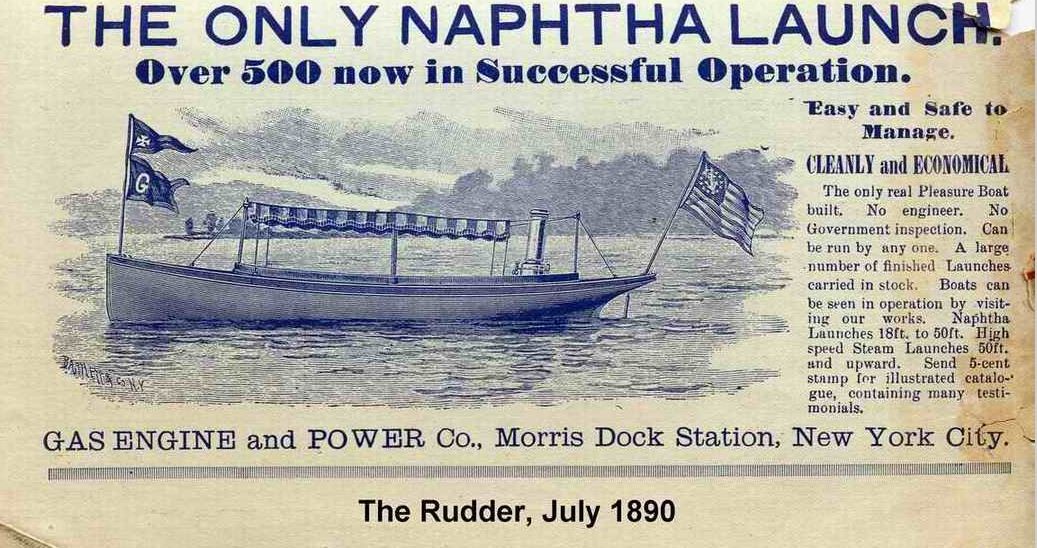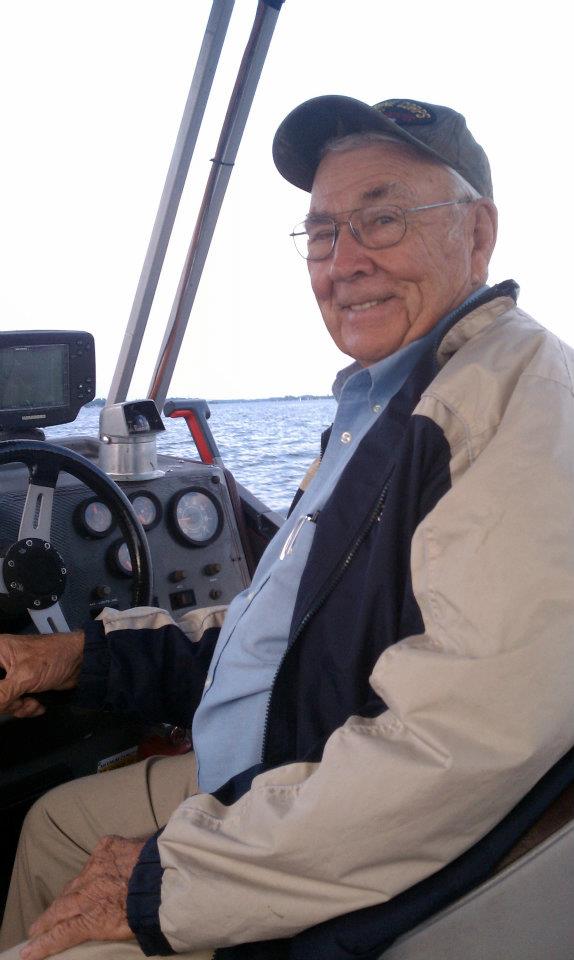My father obtained the boat, which we called the Dobbs, around 1945 or ‘46. The boat was a 21-foot launch-type boat, built in Morris Heights, New York City, around 1904. A quaint little boat, she was narrow, maybe 6 feet wide, with a round bottom. A deep skeg, running from almost midships to the stern, housed the propeller shaft; it was extended by a sturdy flat plate that provided the lower bearing for the rudder. The rear deck extended 3 feet to the rear. The Dobbs had no transom; the hull angled up from the water line to the rear deck and had planking above the propeller, where someone had installed a flat metal plate firmly braced to the hull, which was known as a squat plane.

The Dobbs was perfectly designed – except that any water disturbed by her passing moved up her side and into the boat – thus drenching all aboard. Yes, with or without a top or windshield, the captain and passengers were totally exposed. And The Dobbs was a smooth wooden planked boat with no splash rail, so there was nothing to prevent the flow of water upward – and inward – along the hull!
However, a more comfortable craft never existed; no matter how large the waves, the Dobbs rode them like a duck. Yes, the Dobbswas a very seaworthy vessel.
Along each side of the Dobbs was a series of storage lockers, all brass-hinged with pull handles that flattened when released. There was a hatch on the rear deck equipped with the very same brass fixtures; lifting that hatch revealed the top of the rudder post and the rope that moved the rudder. Steering was done with a side mounted handle near the clutch box and throttle control. It also had an additional steering wheel that was mounted at the bow, complete with spokes, but minus throttle or clutch controls – and the real purpose of which I never knew. However, I did use this steering wheel a great deal on foggy mornings on the St. Lawrence River.
An April Morning
One April morning, my mother (Marjorie Dano Rusho) was in command of The Dobbs, taking her brother to the doctor in Clayton. Uncle Rawdon had somehow broken both arms. The accounts of this tale varied from storyteller to storyteller. Still, about halfway between Calumet Island and the Clayton dock, the Model T engine that had replaced the Naphtha burner many years before, had just quit and my mother's attempts to restart the motor resulted in an explosion and fire onboard.
The Model T engine had a downdraft carburetor that was known to do such things. Luckily, on shore, the Clayton Coal Dock workers saw the explosion and fire. They were working on the Outarde, a coal ship that had previously sunk in a storm at the dock.
A fast response team of men arrived in time to save my mother, her brother, and the Dobbs. They were able to tow the Dobbs to the Clayton dock. I was in school in Clayton at the time. I remember seeing the Dobbs, all burned, and tied up to the Clayton dock. It was big news back then.
Repairs
The poor old Dobbs was badly scorched along the engine area; the years of oil in her bilge had impregnated her planking and her ribs, which was the area where the fire had done the most damage.
Soon, scraped and cleaned, the hull planking was fine, with the addition of a few ribs made of hard white oak, seasoned for years in my father's (Leon Rusho, Sr.) shop. He said he had saved them for this very occasion.
The wood was steamed in a piece of cast iron sewer pipe, which made the new ribs as flexible as rubber. The new ribs were then applied parallel to the damaged ones, and she was as good as new!
The new engine used small 4-cylinder gray main bearings, which was no problem, since my father made new bearings. He poured the Babbit bearings in place, making them out of lead and tin, hardened with tin scraped and honed. In about three weeks, after my father had repaired the engine and boat transom, the Dobbs was ready to go back in the water.
A setback
Unfortunately, during a fast test run downriver to Wright's Point and back, the bearings gave out. We managed to get back to our dock, slowly, with the engine knocking loudly. No one was very happy. With the engine back on the dock, my father determined that the first bearing metal mixture was too soft, so he mixed more tin in the second time and repoured the bearings. This time, it was a success.
Restored beyond her previous glory, the Dobbs was now capable of reaching (maybe) 12 MPH, surpassing her previous top speed of (maybe)10 MPH – she was a fast boat and a pleasure to drive.
School Run
The Dobbs actually backed both ways, steered by a rudder only slightly smaller than a barn door, and swinging a 16 x 16 prop; you could leave Grindstone Island, head for Clayton, and hardly touch the steering handle again.
I was using the Dobbs for my transport to school from Grindstone to Clayton, almost every day. I could leave home a full hour later than if I chose to cross the River with the other school kids on the boat the Mary E., with Captain Bob Garnsey and his chief mate Clara. It was the same 15-minute walk to school from the dock. But I could be home to help with milking the twenty head of cows by hand, clean up, and cool the milk in water pumped from the River, rather than leaving an hour earlier for a morning ride on the Mary E.
Got Fog, no problem
Somedays, there would be heavy fog; no wind, no sun, and no time to wait for the fog to lift or burn off. I had a WW II compass, which I think Buck Dano brought home from the South Pacific after the war, probably a compass from some Japanese aircraft. It was mounted inside of a wooden box, a generous 4 inches in diameter, the dial marked with Arabic numbers, placed on the small bow deck, almost on top of the brass fill pipe. I could set my course across the River, due south and I would be at the dock in Clayton in about twenty-five minutes.
At the ten-minute mark, crossing in the fog, I would stop and listen to the sounds of the terns and wings of eagles and know I was in the right place. At twenty minutes into the foggy River crossing, I would stop and listen for the sound of the foundry at the Frink Factory in Clayton, and knew my destination would be straight ahead through the fog, even if I couldn’t see it.
One foggy morning, the Mary E. crossed directly ahead of me, coming from the direction of Round Island – almost in the steamship channel heading for Lake Ontario; Captain Bob never saw me, and I still wonder where he’d been and where he was going!
Another morning, when I arrived in Clayton at the dock, the Chief of Police helped me tie up the Dobbs As part of our usual conversation, he casually remarked, "Did you know that the Dobbswould hold twenty-one cases of Canadian Whiskey?" Although I am confident today that the sturdy old Dobbs had experienced other adventures on the River, perhaps even during Prohibition, I wish that she could have talked to tell me about them!
By Manley Rusho
Manley Rusho was born on Grindstone Island nine decades ago. This Editor and his many friends wish him continued good health and we thank him for sharing his memories with us.

Posted in: Volume 16, Issue 11, November 2021, History, People, Places
Please click here if you are unable to post your comment.
